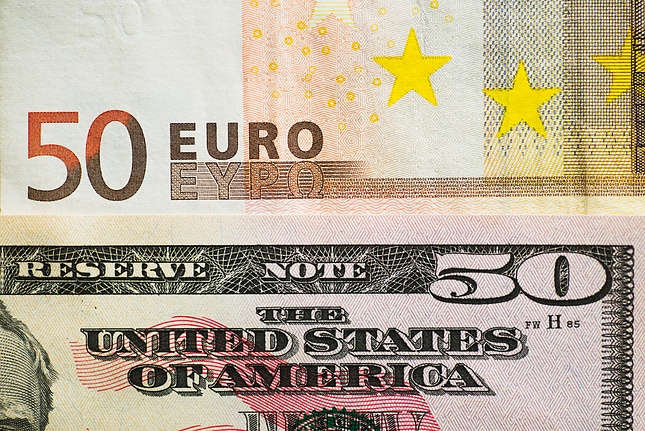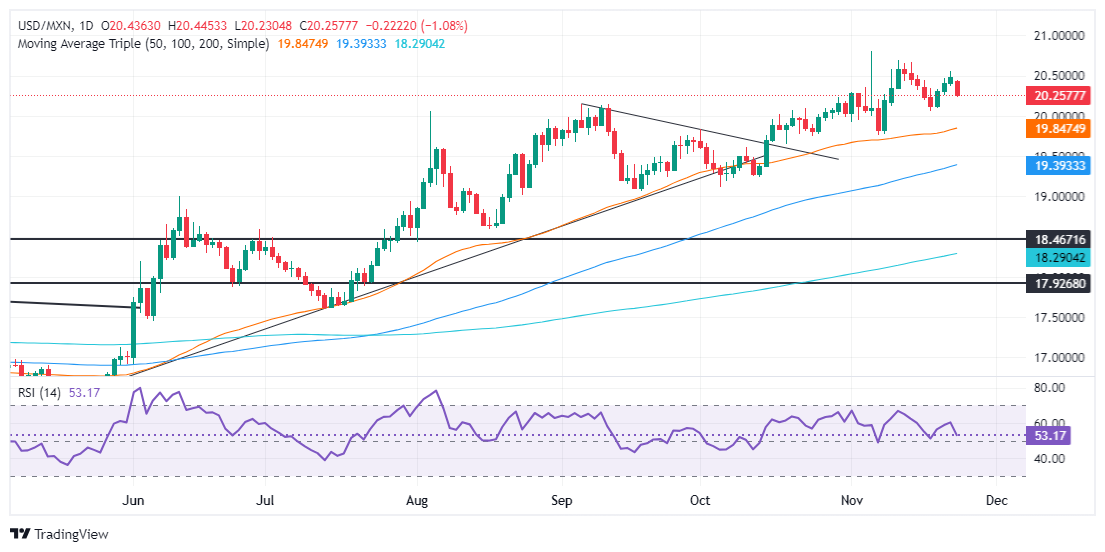- Mexican Peso gains traction against the US Dollar, spurred by an uplift in global risk appetite and a softer Greenback.
- Wall Street responds favorably to President-elect Donald Trump's market-friendly Treasury Secretary appointment, influencing broader market trends.
- INEGI reports progress in Mexico’s disinflation process and a deceleration in Q3 GDP growth, fueling speculation of potential Banxico rate cuts.
The Mexican Peso begins the week on the front foot against the US Dollar due to an improvement in risk appetite and overall US Dollar weakness. US President-elect Donald Trump's pick of Scott Bessent as Secretary of the Treasury was cheered by investors with global equities trading in the green. The USD/MXN trades at 20.30, down by 0.45%.
Wall Street rallied after Trump chose the hedge fund manager since he is deemed a market-friendly pick. Consequently, the Greenback is heavy, losing over 0.40% as depicted by the US Dollar Index (DXY). The DXY dropped beneath the 107.50 mark, undermined by falling US Treasury yields.
Last Friday, the Instituto Nacional de Estadistica, Geografia e Informatica (INEGI) revealed that the disinflation process in Mexico is evolving, approaching the Bank of Mexico's (Banxico) 3% inflation goal. At the same time, despite growing, the Gross Domestic Product (GDP) dipped from 2.1% to 1.6% QoQ in the third quarter, indicating the economy's deceleration.
Kimberley Sperrfechter, EM Economist at Capital Economics, revealed, “The good inflation data raises the possibility of a 50 basis point cut by Banxico in December.” She added that their base case is for a 25 basis points cut, “given the strong Q3 economic activity and upward pressure on US interest rates.”
Banxico revealed earlier on Monday that Mexico's economy posted a current account surplus of $733 million in Q3.
Across the border, the US economic docket remains scarce ahead of Thanksgiving, yet the Chicago Fed revealed the National Activity Index.
Ahead this week, traders await the release of the Conference Board (CB) Consumer Confidence and the latest Federal Open Market Committee (FOMC) Meeting Minutes on Tuesday, followed by Wednesday’s Durable Goods Orders, Initial Jobless Claims and the Fed’s preferred inflation gauge, the Personal Consumption Expenditures (PCE) Price Index.
Money market players have grown more cautious about the Fed cutting rates. The CME FedWatch Tool suggests that investors see a 56% chance of a 25-basis-point rate cut at the December meeting, unchanged from last Friday.
Daily digest market movers: Mexican Peso advances on improved risk appetite
- Last week, Bank of Mexico Governor Victoria Rodriguez Ceja said they’re ready to slash interest rates if inflation continues downward. This would exert downward pressure on the Peso, which has depreciated after former US President Donald Trump’s victory boosted the Greenback, as some of its policies are inflation prone.
- Mexico’s Chamber of Deputies approved the dissolution of autonomous bodies, which, according to experts, puts Mexico at risk of being taken out of the USMCA free trade agreement.
- Mexico’s mid-month inflation rate dived from 4.68% to 4.56%. Core inflation, seen as a better gauge of price trends because it strips out volatile energy and food prices, came below the forecast of 3.72% at 3.58% YoY.
- Data from the Chicago Board of Trade, via the December fed funds rate futures contract, shows investors estimate 22 bps of Fed easing by the end of 2024.
USD/MXN technical outlook: Mexican Peso appreciates as USD/MXN drops below 20.30
The USD/MXN uptrend remains intact, with sellers eyeing a clear break below the previous year-to-date peak of 20.22, which could pave the way to test the 20.00 mark. Once those two support levels are surpassed, the next support would be the November 7 low and the 50-day Simple Moving Average (SMA) around 19.75/82, followed by the 19.50 mark.
Conversely, if USD/MXN resumes to the upside, the first resistance would be 20.50. A breach of the latter will expose the November 22 high at 20.55, followed by the November 12 peak at 20.69. Once cleared, the next resistance would be the year-to-date high of 20.80.
Banxico FAQs
The Bank of Mexico, also known as Banxico, is the country’s central bank. Its mission is to preserve the value of Mexico’s currency, the Mexican Peso (MXN), and to set the monetary policy. To this end, its main objective is to maintain low and stable inflation within target levels – at or close to its target of 3%, the midpoint in a tolerance band of between 2% and 4%.
The main tool of the Banxico to guide monetary policy is by setting interest rates. When inflation is above target, the bank will attempt to tame it by raising rates, making it more expensive for households and businesses to borrow money and thus cooling the economy. Higher interest rates are generally positive for the Mexican Peso (MXN) as they lead to higher yields, making the country a more attractive place for investors. On the contrary, lower interest rates tend to weaken MXN. The rate differential with the USD, or how the Banxico is expected to set interest rates compared with the US Federal Reserve (Fed), is a key factor.
Banxico meets eight times a year, and its monetary policy is greatly influenced by decisions of the US Federal Reserve (Fed). Therefore, the central bank’s decision-making committee usually gathers a week after the Fed. In doing so, Banxico reacts and sometimes anticipates monetary policy measures set by the Federal Reserve. For example, after the Covid-19 pandemic, before the Fed raised rates, Banxico did it first in an attempt to diminish the chances of a substantial depreciation of the Mexican Peso (MXN) and to prevent capital outflows that could destabilize the country.
Information on these pages contains forward-looking statements that involve risks and uncertainties. Markets and instruments profiled on this page are for informational purposes only and should not in any way come across as a recommendation to buy or sell in these assets. You should do your own thorough research before making any investment decisions. FXStreet does not in any way guarantee that this information is free from mistakes, errors, or material misstatements. It also does not guarantee that this information is of a timely nature. Investing in Open Markets involves a great deal of risk, including the loss of all or a portion of your investment, as well as emotional distress. All risks, losses and costs associated with investing, including total loss of principal, are your responsibility. The views and opinions expressed in this article are those of the authors and do not necessarily reflect the official policy or position of FXStreet nor its advertisers. The author will not be held responsible for information that is found at the end of links posted on this page.
If not otherwise explicitly mentioned in the body of the article, at the time of writing, the author has no position in any stock mentioned in this article and no business relationship with any company mentioned. The author has not received compensation for writing this article, other than from FXStreet.
FXStreet and the author do not provide personalized recommendations. The author makes no representations as to the accuracy, completeness, or suitability of this information. FXStreet and the author will not be liable for any errors, omissions or any losses, injuries or damages arising from this information and its display or use. Errors and omissions excepted.
The author and FXStreet are not registered investment advisors and nothing in this article is intended to be investment advice.
Recommended content
Editors’ Picks

AUD/USD shift its attention to 0.6600 and beyond
AUD/USD left behind Friday’s decline and rose past the 0.6500 barrier, meeting resistance once again around the 0.6550 zone on the back of the pronounced sell-off in the US Dollar.

EUR/USD: Initial contention aligns near 1.0330
The sharp decline in the Greenback allowed EUR/USD to regain some composure and reclaim the 1.0500 hurdle at the beginning of the week ahead of key releases on both sides of the ocean.

Gold turns bearish and could test $2,600
After recovering toward $2,700 during the European trading hours, Gold reversed its direction and dropped below $2,650. Despite falling US Treasury bond yields, easing geopolitical tensions don't allow XAU/USD to find a foothold.

MicroStrategy set to push Bitcoin to new highs after 55,500 BTC acquisition, should investors be concerned?
MicroStrategy revealed on Monday that it made another heavy Bitcoin purchase, acquiring 55,500 BTC for $5.4 billion at an average rate of $97,862 per coin.

Eurozone PMI sounds the alarm about growth once more
The composite PMI dropped from 50 to 48.1, once more stressing growth concerns for the eurozone. Hard data has actually come in better than expected recently – so ahead of the December meeting, the ECB has to figure out whether this is the PMI crying wolf or whether it should take this signal seriously. We think it’s the latter.

Best Forex Brokers with Low Spreads
VERIFIED Low spreads are crucial for reducing trading costs. Explore top Forex brokers offering competitive spreads and high leverage. Compare options for EUR/USD, GBP/USD, USD/JPY, and Gold.
